What Are the 7 Types of Logos?
The different kinds of logos can be placed into seven categories: emblems, pictorial marks, logotypes, lettermarks, abstract logos, mascot logos, and combination logos.
Let’s analyze each category.
1. Emblem logos
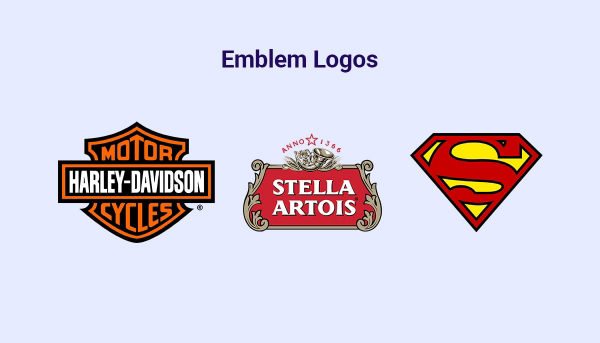
Emblems are the oldest types of logo design. Think of seals, crests, stamps, prestigious school logos, or government agencies.
An emblem is a logo type that features text, a symbol, or imagery inside a geometric shape. It has the power to give a traditional feel to your brand.
They are often richer in detail than other types of logos giving an official look to your brand.
Pros: Once you come up with a good emblem logo, your brand will surely stand the test of time. Moreover, the chances to find another brand with a logo similar to yours are significantly smaller.
They’re memorable, professional, and give a powerful feel to your brand.
Cons: Probably, the only disadvantage to the emblem logo is the scalability. Since they’re detailed, they may not look so good when resized to a smaller resolution or not so readable when placed on a billboard.
Harley Davidson’s “Bar and Shield” logo is recognized worldwide. Its symbol has the shape of a black shield with the word Motorcycles in orange, and over the shield comes a horizontal black bar with Harley Davidson written in white.
Some of the most popular and prestigious universities have an emblem logo, Stella Artois beer, or DC’s Superman.
2. Pictorial mark logos
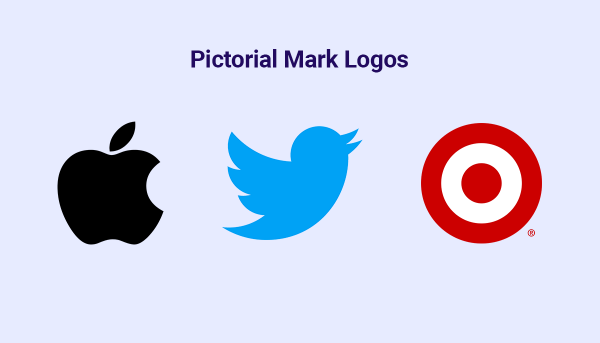
A pictorial mark logo (or a brandmark) is imagery reduced to its symbolistic meaning. This is why, if you’re leaning towards this type of logo design, it has to be extremely representative, containing elements that will make your audience associate it with your brand.
Some huge names, like Starbucks, had two kinds of logos: it changed from an emblem to a symbol over time, only after the company became established on the market.
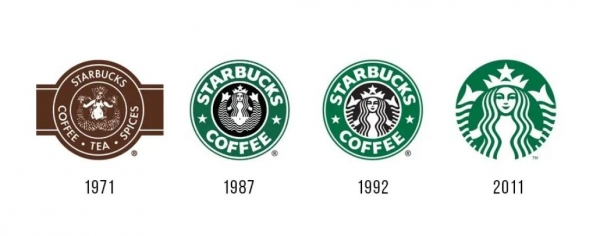
If you’ve just started your business and want to adopt this type of logo, you can still go for a brand mark. Just keep in mind that for a while, you’ll have to use a wordmark associated with the symbol until people get acquainted with your products or services.
Pros: Maybe your brand can be represented through a simple image/symbol. Think of Apple. Its name is also its symbol, and it works perfectly, as their name is drawn literally from the brand mark.
Another great way to use this type of logo is to convey a meaningful idea through a symbol, where the words can’t express it well enough.
Cons: If your business is still fresh and you didn’t manage yet to have a solid base and a stable target audience, it’s better to start with something more explicit for your brand’s logo and adapt it as a brandmark later.
As I said, Apple can use this simple logo without any additional text because their brand name is the symbol’s name.
Other pictorial mark logos are the ones for Twitter and Target. They can now be used without any text, but this is due to their popularity. At first, the brand’s name appeared in the logo as well.
3. Logotypes
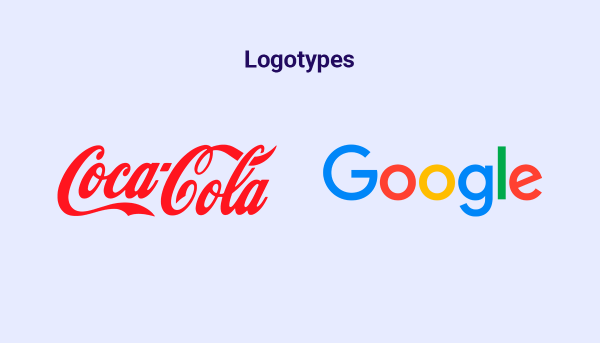
Among the most powerful types of logo design out there, we have the logotypes, also known as the wordmark logos.
The logotype definition is simple. They’re composed entirely of the company’s name. On a logotype design, you won’t find symbols, graphic patterns, or emblems.
Since the main feature of the logotype design is typography, the best choice is to have a font specially designed for your logo.
The fonts’ style and color will create the whole identity of your brand.
By doing so, you’ll create uniqueness through your font and brand’s name. What’s even more remarkable about a logotype design is that you’ll help people make the connection between the logo and the brand in an instant.
Pros: It’s a simple yet impactful way to get your brand’s name out there. Once you have the font and your logo’s style, you can mix it with other elements and create logo variations.
The logotypes also help new businesses that need fast recognition, or if your personal name gives your brand’s name.
Cons: The logotype won’t work if your brand has a long name. Also, in time you may have to change the fonts to keep up with font design trends.
The logotype examples above need no further introduction. They are definitely the most famous logotypes in the world.
4. Lettermark logos
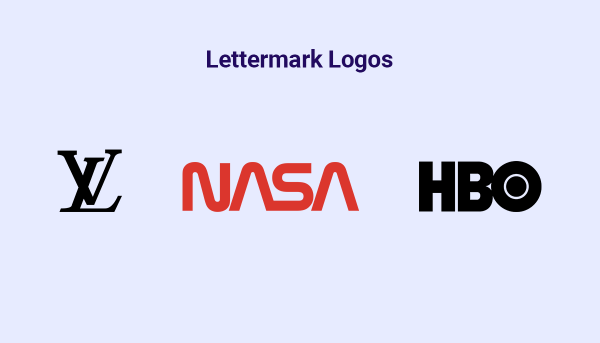
Lettermarks (or monograms) are a cool way to reduce your brand’s name to an acronym. Take the initials from each word of your brand’s name, and you’ve got yourself a logo.
The only part left is to think of typography. You have to come up with an eye-catching and unique font since the lettermark logo design uses just a few letters.
Pros: If your brand’s name has several words, then this logo kind is perfect for you, especially if you don’t want to use only a visual symbol.
Cons: If you’re a new company on the market using a lettermark logo, it may confuse your audience. But this situation has an easy solution. At first, you can use your lettermark logo, and underneath it, place the full name.
HBO (Home Box Office) boldly uses the lettermark logo, with the letter “O” that looks like a camera lens. Other examples are the National Aeronautics and Space Administration (NASA), which also uses an acronym written in a futuristic and unique font, and famous clothing brands like Louis Vuitton.
5. Abstract logos
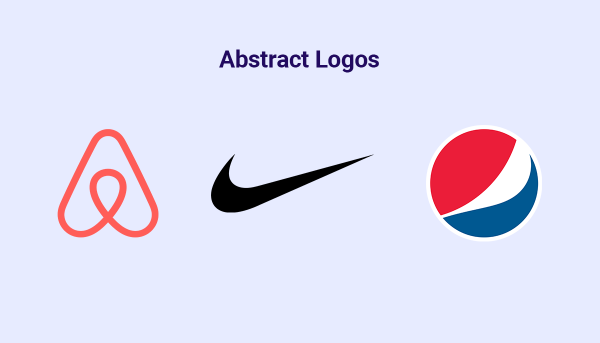
Next on the logo types list is the abstract logo, which is made of an image without any letters. It’s a visual representation of a feeling you want your brand to evoke.
It can be a bit risky to use when you’re new on the market, as not everyone interprets an abstract representation the same way. Still, with a good strategy behind it, your brand’s logo will differentiate you from all the competitors out there.
Pros: With an abstract logo that still manages to showcase your brand’s identity, you’ll create something unique and instantly recognizable on the market.
Another reason can be the versatility of using it in advertising campaigns and on branded merchandise.
Cons: If you’re a new brand making a name for itself, you may have to put some extra effort in helping people know your brand’s reputation. The solution here is to create an abstract logo that conveys the specific feeling you’re aiming for, and maybe join in with the brand’s name for a while, just until people get to know you.
Nike’s abstract logo, the famous swoosh, can work alone because the brand is highly popular, but you can still see it sometimes together with the brand’s name.
Its abstract logo perfectly represents the idea of movement. Just do it and check it on the list as done.
Other notorious examples are Airbnb and Pepsi, which are sometimes accompanied by their brand names, but even without them, you recognize them immediately.
Airbnb actually transitioned to an abstract logo that brings together its core values.

6. Mascot logo
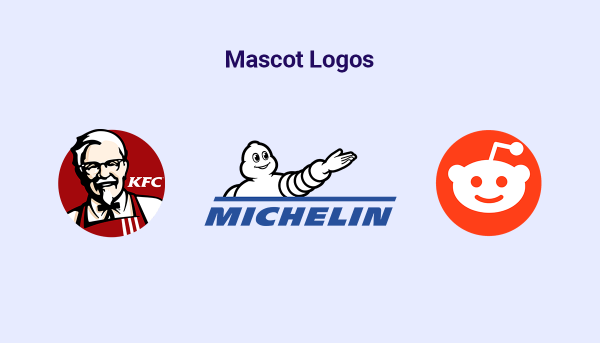
A mascot logo is a drawing of a person or a non-human entity that received human form or human attributes.
This type of logo creates a friendly and positive feeling towards your audience. You can use a mascot logo and give it different expressions and representations, depending on the message you’re trying to convey.
Mascot logos are used for sports teams, food brands, or service companies.
Pros: If your brand targets families and children, the mascot logo is a great way to go. It will help you establish a fun and friendly approach.
Cons: You definitely can’t use a mascot logo when your brand wants to send a serious, professional message.
The mascot logos used in the image above are sincere and happy, inviting their audiences to try the brands.
7. Combination logo marks
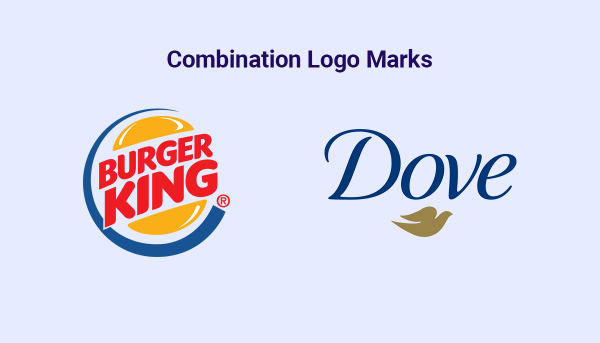
This one is a mix of multiple different types of logo design.
If you can’t decide on a kind of logo from the ones mentioned above, just combine them.
Place lettering near symbols, abstract forms, mascots, or create a fusion between a monogram and an abstract logo. Whatever works for you.
You just need to pay attention to the message you’re trying to send through your logo and remember that it is part of your brand’s identity.
So, if you want to include imagery into your logo but feel like you need words to make sure people get exactly what you’re saying, then this is a safe bet.
The great thing about this kind of logo is that once people know about you, it’s easier to be flexible on the logo and use it in various ways. In some situations, you can use just the text. In others, just the imagery.
Pros: This is an excellent option if you want your future logo to be adaptable to changes.
Cons: If you’re aiming for minimalism and simplicity, this type of logo may overload your visual branding.
If you want the best of both worlds, look at these examples of logos above to see how they’re using a symbol together with a perfectly blended text.
Conclusion
Designing your brand’s logo is a creative and fun process that sets the foundation of your business identity.
When you start brainstorming ideas for your logo design, think of your brand’s core values and how you’ll want to present them to the world—this is how your brand will be remembered, after all.
Based on these logo types, try to design multiple options for your brand’s logo, show them to a few people, and see how they respond to them. This should be the test you need to perform.
I hope this article with the seven different types of logo design was helpful and gave you some ideas about which type of logo design would best fit your business.

No comments:
Post a Comment